Distinguished Critique: Green Lantern: The Road Back Review
Though unbalanced in its characterization, this volume is constructed upon strong themes of redemption and growth
—by Nathan on August 7, 2025—

During the tail end of the 80s and into the early 90s, Hal Jordan’s version of Green Lantern received a facelift courtesy of Christopher Priest (then going by Jim Owsley), Keith Giffen, and Gerard Jones across two limited series: Emerald Dawn and Emerald Dawn II. These series modernized Jordan for the post-Crisis world, casting him as a hot-headed pilot thrust into the weighty responsibilities befitting a Green Lantern. Protecting his specific "sector" while juggling consequences for a few Earthbound misadventures, Hal learned the all-important lesson of taking responsibility for both sides of his life, the relatively normal one and the portion where he scoured the cosmos alongside the Green Lantern Corps.
Shortly after the Emerald Dawn era wrapped up, Hal was gifted a brand new ongoing series. Perhaps as a fitting challenge for the often temperamental Jordan, writer Jones saddled him with two other Lanterns: the generally obnoxious Guy Gardner and the then-traumatized John Stewart. The Road Back collects the first eight issues of that series (and, as far as I am aware, the only issues of this series collected until Jordan's "Parallax" phase, until DC's Finest collections get to them, which I feel is a possibility), offering an opening arc which allows our ring-wielding warriors the opportunity to grow beyond the broken, burnt out places we find them.
Green Lantern: The Road Back
Writer: Gerard Jones
Penciler: Pat Broderick
Inker: Nelson DeCastro, Bruce Patterson
Colorist: Anthony Tollin
Letterer: Albert T. DeGuzman
Issues: Green Lantern #1-8
Publication Dates: June 1990-January 1991
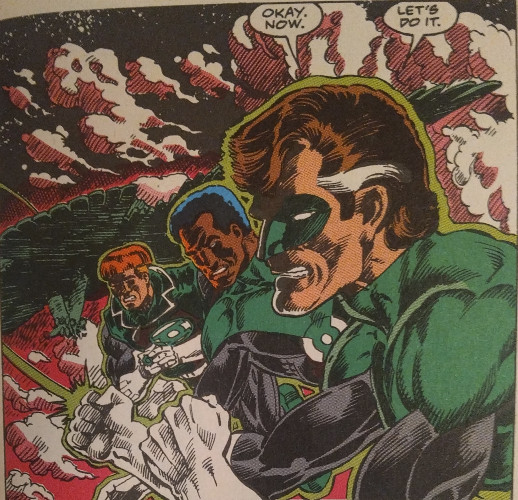
As I noted in the introduction, this volume is the only collection involving post-Crisis, pre-Parallax Green Lantern issues that I am aware of–the volume’s back cover itself advertises three other collections, two comprising each of the Emerald Dawn limited series, the other collecting "Emerald Twilight," which I also own and hope to review in the future. My intention for this review was to dive a little deeper into Hal Jordan’s post-Crisis history outside the limited series, which I had assumed were set some time in the past, much like Frank Miller's "Year One" was a "flashback" story set prior to contemporary Batman issues. I was wrong. As the volume (and series) opens, Hal has been Green Lantern for fifteen years, some of that time covered in pre-Crisis narratives.
A decade-and-a-half of adventuring has taken its toll on Hal, and as Jones dives into these issues, he sets Hal up as a man wandering and wondering. He's taking a step back from all the protecting he's been doing, saying good-bye temporarily to intergalactic interruptions and more down-to-earth escapades. He has the ring, but for now, he just wants to be Hal.
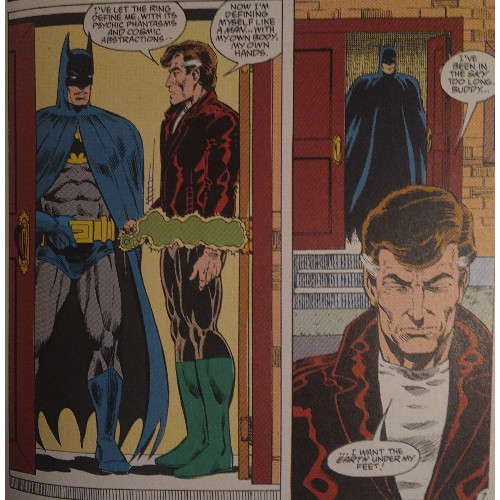
Jordan is looking for a new lease on life, and in an arc which parallels Dennis O'Neil and Neal Adams' Green Lantern/Green Arrow adventures (in more ways than one, as we shall see), he spends the first few issues drifting across the country, looking for something to give him definition and meaning outside his fancy costume, domino mask, and emerald jewelry. Jones allows that central notion to define the entirety of these issues, developing not only an intriguing narrative for Hal but watching how that narrative impacts the development of Guy Gardner and John Stewart, two other green-gilded guardians of Earth. Guy, a card-carrying member of the Justice League (do they carry cards, like the Avengers?), is initially ruffled when his teammates encourage Hal to join the League, only to become more nonplussed when Hal declines the offer, as if the famous super-team isn't good enough for the popular Green Lantern. Thus, Guy takes it upon himself to challenge and push Jordan at every turn, trying to figure out why the heck the veteran Green Lantern is so willing to just give up his power…though Guy isn't as interested in determining why Jordan has set aside the responsibility.
Guy is presented as loud-mouthed and crude as ever, and as he attempts to figure out why Hal would sacrifice the thing which makes Jordan (and, by extension, Guy himself) stand out from the rest of teeming humanity, he's confronted time and again with Jordan's stubbornness. It's our characters' two greatest flaws slapping each other in the face repeatedly, and Jones subtly works in the idea that maybe, just maybe, Guy has some redeeming qualities in him that don't need a "One punch!" to the face from an angry Caped Crusader to activate.
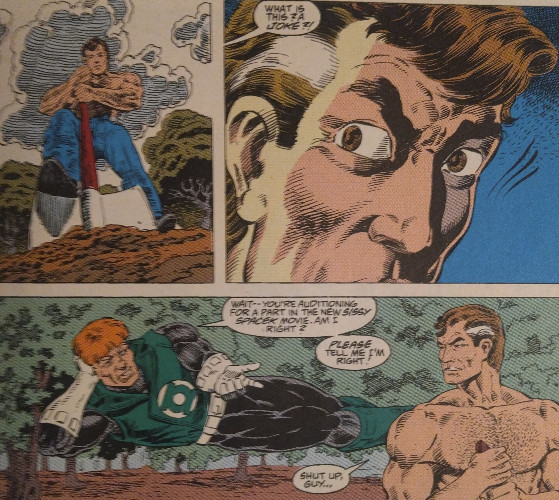
Presented as his regular scummy self–which, if seen in a certain light, disturbingly parallels Jones own fall from grace–Guy is difficult to appreciate as a character across these eight issues. He's allowed some redemption, which works in the latter half of the issues collected, and a complaint I originally developed about his "heel turn" towards being more heroic is somewhat crippled given further contemplation. Jones, adequately, plants enough frustration in Guy that a pivotal decision to aid a fellow hero feels more organically developed than I originally gave the writer credit for creating. Even if Guy's decision feels a tad truncated (or, perhaps, just occurs a little later in the story than I may have appreciated), it isn't like his choice feels completely out of the blue…or would that be the green?
I also find myself somewhat torn about Jones' depiction of Jon Stewart. My interest in this volume was initially piqued when I realized these issues were published the year after Jim Starlin's Cosmic Odyssey, the DC "event" of 1989. I critiqued Starlin's use of Stewart in that series–about halfway through the narrative, Stewart makes a mistake which obliterates a planet. Instead of allowing for unique growth to come from such a horrifically tragic error, Starlin has Martian Manhunter berate Stewart. I believe a more compassionate approach was required, and as this series opens, Stewart is indeed weighed down by his actions. He's not dramatically anguished in the way Starlin left him; he's looking for an opportunity to prove himself in the wake of such a costly error. Like Hal Jordan, he's a man searching, and in his particular case, Stewart is seeking redemption. And Jones gives him an opportunity. Sorta.
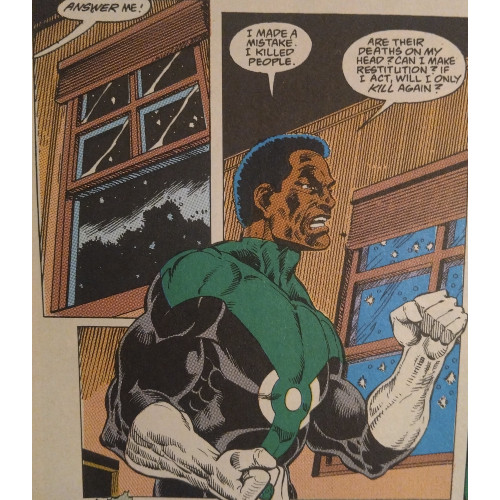
This is where my mind grates a little against Jones' use of Stewart. This particular Green Lantern is driven by a noble pursuit, to save lives where he last accidentally ended life. I looked forward to an epic arc where Stewart found worth in his calling again, similar to Jordan (and, in a sense, Gardner as well). And he does, but the matter in which Jon seeks redemption leads him to play an unwitting role in a madman's scheme, rendering him ineffective for much of the eight-issue arc. His push for personal reconstruction comes at the very end and with a heaping helping of Hal Jordan (Hal-burger Helper?) enabling him to reach that position. Jon's arc feels somewhat crippled as a result, left to the devices of others to guide him in the direction he so valiantly steers himself as this story opens.
The narrative's final issues feel a little blended together as well, providing a surprisingly unique pacing problem: Jones' final fracas lingers too long, a three-and-a-half issue crescendo which builds and builds and builds with ring-slinging violence as our three Lanterns battle alien forces to defeat their primary adversary, a holdover himself from O'Neil and Adams' classic adventure. The plot itself is entertaining, with Jones revisiting locations from those original narratives, and the lead-up to the opening salvo derives tension from the villain's scheme as he creates a patchwork planet (not unlike the Beyonder's Battleworld) out of cities across the galaxy, including a few familiar Earth locations. Intriguing as this is, it devolves into the aforementioned fight, taking up almost half of the narrative. Does it allow great moments for each character? Yes (though we've already established Jon's diminished role). But each issue involved in the fight ends on some kind of cliffhanger. Our Lanterns try a strategy, they fail, and just when it seems all hope is lost, they either devise a new scheme or face rescue. And this goes on for nearly 80 pages. The fight is necessary; it just strangles the final three issues, allowing for brief moments of character in between bouts of energy and explosions. I would have preferred Jones consider decreasing the number of pages dedicated to the fight.
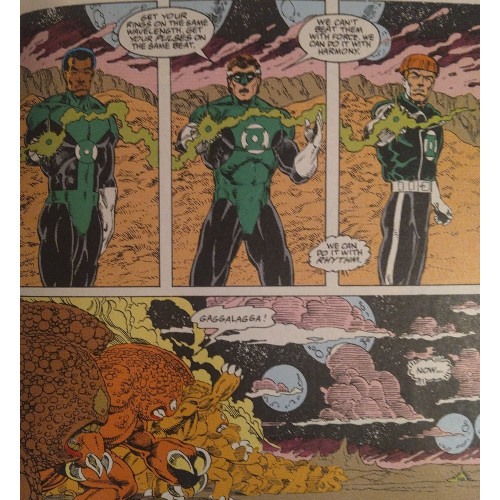
Aside from the constant cosmic kerfuffle careening across the last issues, The Road Back brings a new (for the early 90s) Green Lantern series back rather successfully. Jones' focus on character development, with the exception of not allowing Jon Stewart a full arc, means at least two-thirds of our green ring-slinging guardians experience internal change, always a positive when reading a narrative, be it paneled or prose. Note I mentioned nothing of any eerie, grimy darkness festering at the soul of this series like so many 90s narratives–that's because there isn't much of any found. There isn't much humor either, so mark this as drastically different from Gardner's appearances in the lighter Justice League International. These opening issues exist in an easy middle, largely serious but not ridiculously so. And they hinge nicely upon history, not just harkening back to the classics for the sake of nostalgia, but relying on both the past and then-recent stories to inform what happens here.
From what I can tell, a large gap exists between these issues and Hal's fated turn as Parallax. I don't know why the remainder has been uncollected. You get post-Crisis books starring Batman and Superman that have multiple volumes collecting several chunks of issues, and then you get titles like Green Lantern or The Flash which remain woefully uncollected until a dramatic shift makes those issues interesting or valuable–in the case of Wally West, it was coming under the thumb of Mark Waid; in the case of Hal Jordan, it's his villainous transformation. But that'll be a tale for another blog.